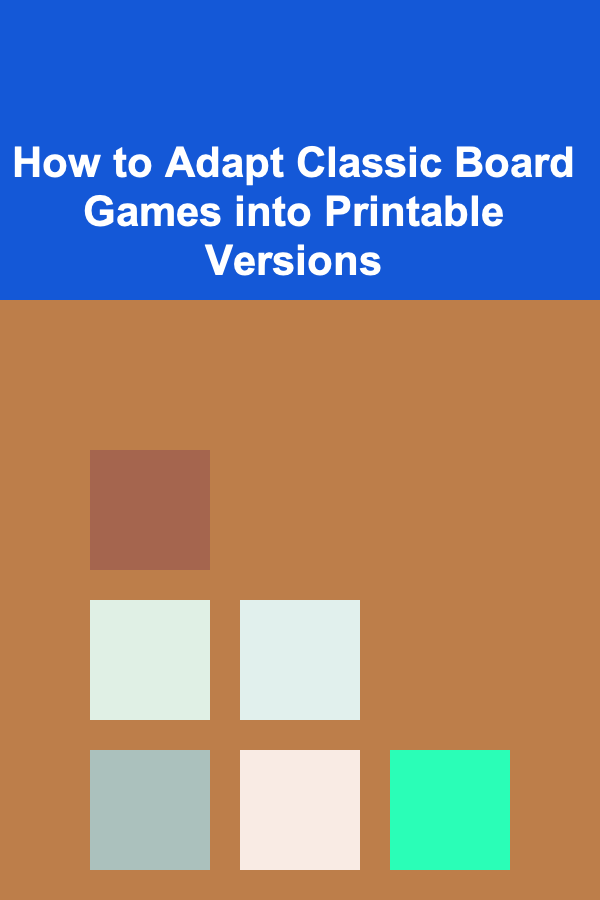
How to Adapt Classic Board Games into Printable Versions
ebook include PDF & Audio bundle (Micro Guide)
$12.99$8.99
Limited Time Offer! Order within the next:

Board games have been a source of entertainment for centuries, fostering creativity, strategy, and social interaction. In recent years, the desire to play traditional games has persisted, but the means of accessing them have changed. The digital age has brought with it new ways to play, but there's something inherently satisfying about the tactile experience of holding game pieces, rolling dice, and interacting with a board. However, not everyone has access to physical versions of popular games, and the cost of purchasing them can add up. One solution is to adapt classic board games into printable versions that can be easily reproduced at home.
In this comprehensive guide, we will explore the process of adapting classic board games into printable versions. This involves understanding the components of the game, the logistics of creating printable materials, and ensuring that the game remains functional and enjoyable when transferred into a printable format. Whether you're a board game enthusiast, a parent looking to create a DIY game for your children, or someone just interested in bringing classic games to life in a new format, this article will provide the necessary steps and considerations for adapting games.
Understanding the Essentials of Board Game Components
To adapt any classic board game into a printable format, you need to first understand the core components that make up a typical board game. Classic games often have a few key elements: the game board, game pieces (such as tokens or pawns), cards, dice, rules, and sometimes money or other physical components. Your goal is to reimagine these components in a printable form, ensuring that they remain functional and engaging.
Key Components of Classic Board Games
- Game Board : The board serves as the central playing space and often has a distinctive layout that reflects the nature of the game. For example, Monopoly has a square board with spaces, while Clue has rooms and pathways connecting them.
- Game Pieces : These include the tokens or pawns that players move around the board. They often have unique designs, such as the playing pieces in Risk or the little character tokens in Monopoly.
- Cards : Many classic games use cards as a central mechanic. For example, Uno , Go Fish , and Cards Against Humanity rely heavily on cards for gameplay.
- Dice or Other Randomizers : Many games feature dice or spinners that determine movement or outcomes, such as in Yahtzee or The Game of Life.
- Rules: Every game is built around a set of rules that dictate how to play, how to win, and how players interact with the game world.
Once you have a clear understanding of the components, you can move forward with designing your printable version.
Choosing Which Games to Adapt
Not all games are suited to being printed at home. While many board games have simple components that can easily be recreated, others may be more complex, requiring specialized materials or equipment. It's important to start with games that are adaptable and can still be fun when converted into a printable format.
Games That Are Easy to Adapt
- Monopoly: A board, cards, money, and game pieces. The structure of Monopoly makes it relatively easy to design a printable version.
- Scrabble: A game of letter tiles and a board. A printable version can easily be created by using printable letter tiles and a pre-designed board.
- Checkers and Chess: With a board and simple pieces, both of these classic games lend themselves well to printable versions.
- Connect Four: This game requires just a grid and colored discs, which are easy to replicate in a printable format.
- Battleship: Involves grids and ship markers, which can be easily printed and marked with a pencil.
Games That Are More Difficult to Adapt
- Risk: The game involves complex territories, armies, and dice, which may require more than just a simple printout to fully recreate.
- The Game of Life: While the board can be printed, the unique spinner and miniatures may make it difficult to adapt without creating physical components.
- Clue (Cluedo) : The room cards and miniatures used to represent characters in Clue are harder to replicate with just printing.
When deciding which game to adapt, start with simpler games, and move on to more complex ones once you're comfortable with the process.
Creating Printable Game Components
Game Board
The game board is typically the most important and most intricate component when adapting a game. Depending on the game you're creating, the board could be a simple grid (like in Chess or Checkers ) or a more complex layout (like in Monopoly or The Game of Life). To make your game board:
- Design the Board: Use a graphic design tool (such as Adobe Illustrator, Canva, or even Microsoft Word) to create a digital version of the game board. If you're recreating a well-known game, you can find templates online or create a simplified version from scratch.
- Ensure Proper Dimensions: Consider the size of the board and the scale of the squares or spaces. For example, Monopoly spaces are usually around 2 x 2 inches, but you might want to adjust this based on your printer's capabilities.
- Consider Foldability : If the game board needs to be folded (such as in Monopoly), ensure your design accounts for folding lines, ensuring the board fits within a manageable space.
Game Pieces
Game pieces can often be the trickiest part of a printable game. For some games, you can simply use tokens that you already have at home. For others, you'll need to get creative:
- Printable Tokens: For simple tokens, you can create circular designs that players can cut out. Ensure the designs are clear and simple, such as using a circle with a picture or symbol to represent each player's piece.
- Alternative Tokens: If you don't have suitable tokens, you can use coins, buttons, or even small pieces of paper with marks on them.
- 3D Pieces : If the game requires 3D pieces (like the houses in Monopoly), you can print flat designs and then cut and fold them to create small stand-up pieces.
Cards
Cards are an integral part of many board games. Thankfully, creating printable cards is relatively easy, especially with the help of templates:
- Designing Cards : For games that require cards (like Uno or Go Fish), you can create the cards by designing a template with your graphic design tool. Standard playing cards are 2.5 x 3.5 inches, so this can be a good starting point.
- Card Content : Make sure the card content is clear and legible. For games like Monopoly, where you have specific property names and values, ensure everything is easily readable.
- Printing and Cutting: After designing the cards, print them on heavy paper or cardstock to give them some durability. For extra sturdiness, you can laminate the cards once they're cut out.
Dice and Randomizers
Many board games require dice or other randomizing elements to add an element of chance to gameplay. While you can't always print a physical die, there are other ways to replicate the dice roll experience:
- Printable Dice: You can design dice faces using a graphic tool and print them out. These can then be cut out, folded, and glued to create physical dice. There are also online dice generators you can use to simulate dice rolls if you prefer to keep it digital.
- Spinners: For games that use a spinner, you can create a printable spinner with segments labeled appropriately for the game. The spinner can be made using a circle template and an arrow, then placed on a pivot point for use.
Assembling Your Printable Game
Once you have all the components designed and printed, it's time to assemble your game. This process will vary depending on the type of game, but here are some general tips:
- Print All Materials: Ensure you print enough copies of each component. For example, you might need multiple decks of cards or several game pieces.
- Cut and Prepare: After printing, carefully cut out each piece. Use a paper cutter for straight edges or scissors for more intricate shapes.
- Laminate (Optional): To extend the lifespan of your printable game, consider laminating key pieces like cards and the game board.
- Packaging: Create a simple box or pouch to store your game pieces and cards. A plastic bag or homemade box will suffice to keep everything together.
Adapting Game Rules for Printables
Finally, the rules of the game should be clearly laid out. You can create a printable rulebook that is easy to follow. If the original rules are complex, consider simplifying them or providing a step-by-step guide to make it easier for new players to pick up the game.
Simplifying Complex Games
- Clarify Ambiguous Rules: Sometimes classic board games have rules that are not entirely clear. In the printable version, make sure you explain the rules as clearly as possible.
- Provide Visual Aids: Adding images or diagrams to the rulebook can help clarify how certain game mechanics work.
Conclusion
Adapting classic board games into printable versions is a fun and creative way to bring your favorite games to life. Whether you're looking to save money, make a DIY game for friends and family, or simply enjoy the challenge of recreating a game in a new format, the steps outlined in this guide will help you create a functional and enjoyable printable version of almost any game. With some patience and creativity, you can enjoy the timeless fun of board games in the comfort of your own home without having to invest in expensive commercial versions. Happy gaming!
Reading More From Our Other Websites
- [Home Party Planning 101] How to Create a DIY Party Hat or Favor Station for Fun and Creativity
- [Organization Tip 101] The Best Power Tools for Easy Crown Molding Installation
- [Home Maintenance 101] How to Choose the Best DIY Home Repair Projects for Beginners: A Guide to Smart and Safe Home Improvements
- [Home Staging 101] How to Calculate Staging Cost Per Room for Your Home Sale
- [Personal Financial Planning 101] How to Financially Plan for the Cost of Aging and Long-Term Care
- [Organization Tip 101] How to Maximize Space in a Small Dining Room
- [Home Storage Solution 101] How to Store and Organize Holiday Decorations in a Smart Way
- [Gardening 101] How to Identify and Manage Pests in Your Garden
- [Skydiving Tip 101] How AFF Training Transforms Your Skydiving Skills: From Novice to Pro
- [Rock Climbing Tip 101] Preventing Falls: Injury-Reducing Practices for Beginners and Pros Alike

How to Curate Meaningful Decor with Minimalist Aesthetics
Read More
How to Find Remote Work Opportunities for Beginners
Read More
How to Discover Advances in Traumatic Brain Injury
Read More
The Art and Science of Homemade Jams and Preserves: A Comprehensive Guide
Read More
How to Eat Healthy to Boost Your Mood
Read More
10 Tips for Fitness Trainers to Build a Strong Social Media Presence
Read MoreOther Products

How to Curate Meaningful Decor with Minimalist Aesthetics
Read More
How to Find Remote Work Opportunities for Beginners
Read More
How to Discover Advances in Traumatic Brain Injury
Read More
The Art and Science of Homemade Jams and Preserves: A Comprehensive Guide
Read More
How to Eat Healthy to Boost Your Mood
Read More